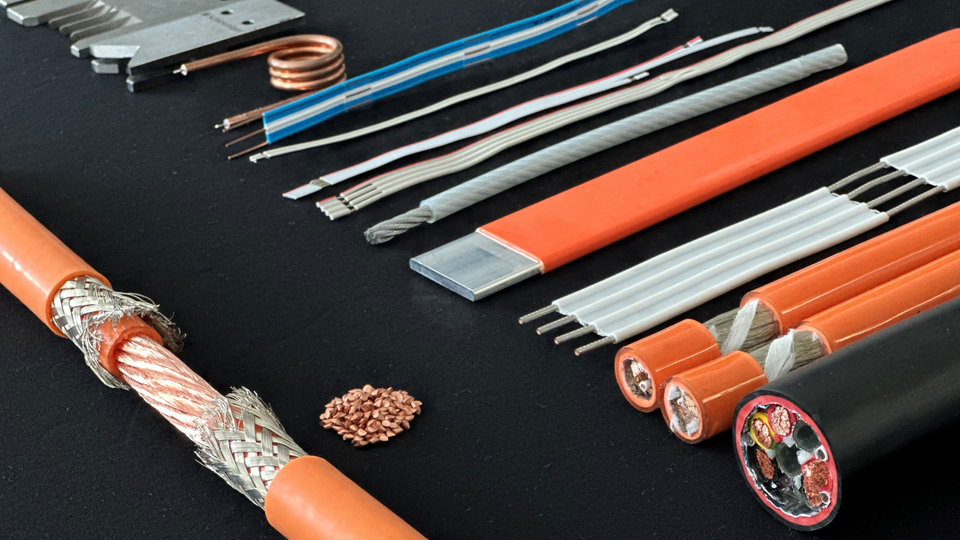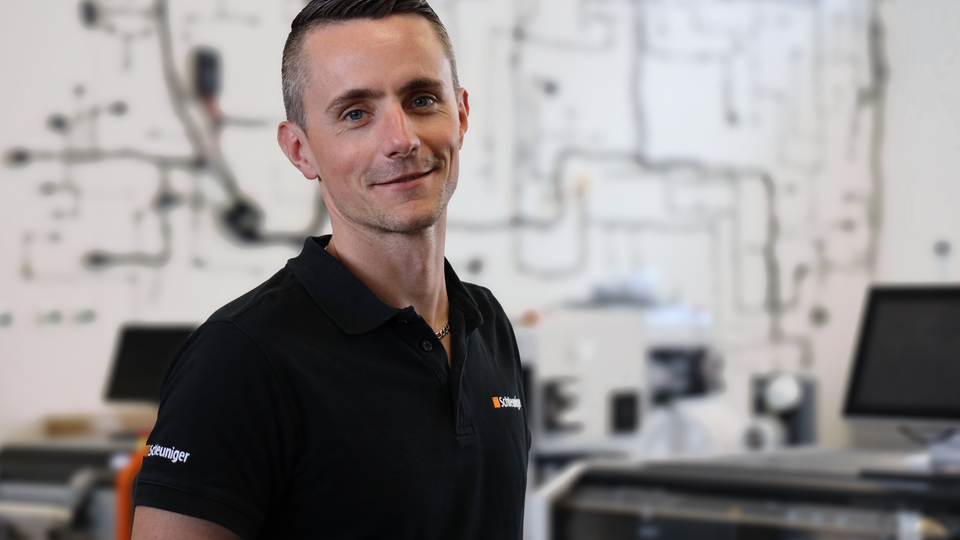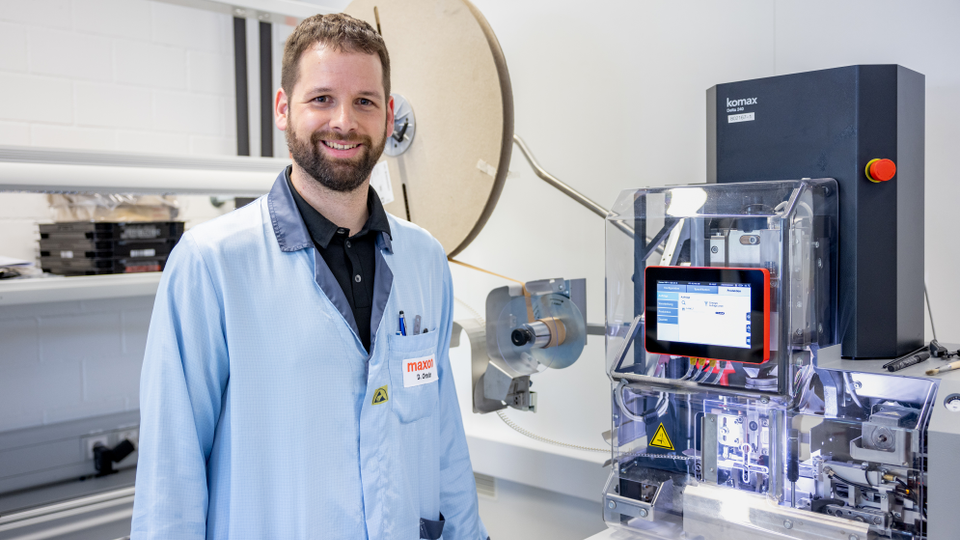Tento obsah je k dispozici ve dvou jazycích: němčina a angličtina.
Zvolte prosím svůj oblíbený jazyk kliknutím na příslušnou ikonu vlajky.
Komax Connect Slashes Reject Rates
Technology & Innovation
Digital machine monitoring solutions that analyze real-time process data across plants are more in demand than ever before. This was also the case at the PKC Group, part of the Motherson Group, which wanted to optimize individual areas of production with the help of digital services based on defined company goals. No sooner said than done. The specialists at the Komax Group successfully installed the Komax Connect cloud service at four PKC sites – and were able to successfully reduce reject rates of over 36 percent (from 2.2% to 1.4%), alarm messages even by as much as 37.6 percent, and also effectively reduce downtimes. In an interview, Hassan Abowafia and Audrius Mikalauskas from PKC talk about how the collaboration went and what they were able to achieve with Komax Connect.

Do you want to be immediately notified if your production environment isn't functioning as expected? Do you want to be aware of all of your machines' performance data in real time? Do you want to reduce downtime and maintain the availability, reliability, and quality of your production equipment at all times? You aren't the only one! Manufacturers in the wire processing industry face increasing customer demands when it comes to quality and a high degree of flexibility in their production processes and have to make their production processes as lean, flexible, and efficient as possible. They are looking for ways to increase automation, optimize production processes, and intervene immediately in production using digital solutions that analyze real-time process data across plants. While common Manufacturing Execution Systems (MES) allow the production process to be guided, controlled, or monitored, the ability to capture and analyze real-time data that provides insights into the productivity rate of machines is highly limited with existing solutions. Machine information or manufacturer-specific data required to identify sources of error and therefore optimize the production process over the long term is often lacking.
The PKC Group – a renowned solutions provider in the global commercial vehicle industry and part of the Motherson Group since 2017 – also needed to digitalize certain parts of production and optimize them by obtaining and evaluating real-time machine data from any location. To achieve its corporate goals, PKC brought in the specialists from the Komax Group and the cloud-based service Komax Connect. In the initiated data analysis project, various machines at four PKC locations – in Serbia, Poland, Lithuania, and the United Arab Emirates – were equipped with Komax Connect. The aim was to improve quality and reduce downtime, setup times, and alarm messages, as well as to identify problems in production.
Data Available Instantly and Anywhere
With Komax Connect, the PKC Group opted for a digital service that provides comprehensive and precise information on production equipment data with fully automatic real-time data collection and evaluation. Komax Connect records machine data from ongoing production, makes it available to a wide range of organizational units from anywhere, and thereby enables the real-time comparison of the production performance of multiple sites and machines. All of the data is processed in real time in the Komax Cloud and stored on specially secured cloud servers. This means that reports with all of the relevant statistics can be generated quickly, the problem is immediately visible in the event of machine downtime, and the system informs users when specific irregularities occur. This makes Komax Connect easy to integrate into existing processes.
The PKC Group benefited immensely from the advantages of Komax Connect during an initial introduction phase with promising results: The wire reject rate was reduced by 36.4% (from 2.2% to 1.4%), the terminal reject rate by 39.5% (4.3% to 2.6%), the seals scrap rate by 38.6% (4.4% to 2.7%) and alarm messages by 37.6% in one of the four plants. The number of alarm messages across all plants decreased significantly and has been reduced by precisely 84.3%.
In an interview, Hassan Abowafia, Director of manufacturing engineering for Europe & South America, and Audrius Mikalauskas, Regional C&C Process Engineer, explain how the collaboration with Komax’s specialists went and what insights they gained from the first phase of the integration of Komax Connect into the PKC production landscape. The white paper, on the other hand, provides insights into the progress of the project, communicates the results achieved, and shows how IIoT services proactively support customers.

Hassan Abowafia, Director of manufacturing engineering for Europe & South America at the PKC Group.

Audrius Mikalauskas, Regional C&C Process Engineer at the PKC Group.
The experts from Komax carried out a machine data analysis in your company with the aim of optimizing certain subareas of your production with the help of digital services. What improvements did you want to achieve in the production areas of your plants?
Hassan Abowafia:
Our main goal was to obtain real-time data in order to make accurate performance evaluations and gain full transparency in the production process. This was to enable various quality improvements that contribute to our overall equipment effectiveness and are part of our KPIs. Specifically, we wanted to analyze downtime, setup time, alarms, and scrap rates to identify problems in production. In fact, Komax Connect offered us much greater transparency and real-time machine information. We particularly appreciated the fact that Komax Connect provides us with various visualizations that allow us to make adjustments and modifications to the production process in the shortest possible time and thus facilitate decision-making considerably.
Please tell us how the cooperation with the experts from Komax went?
Audrius Mikalauskas:
At the beginning of the project, we defined our main goals together with the experts from Komax, then regularly exchanged ideas in monthly online meetings over the course of six months, and analyzed and monitored the goals we had set.
We initially decided to install Komax Connect at four sites and connect three to four machines per site to the cloud service. The gateways were physically installed at the sites we selected, which involved some effort for our engineers and the IT department. One particular challenge was the installation of the gateways and the associated firewall settings. With the support of Komax's experts, fine adjustments were made to ensure that the connection from the machine to the Komax Connect cloud service was successful. It was therefore a close collaboration between Komax and the PKC Group, which was very positive throughout.
Cloud solutions are not yet very widely used in the wire-processing industry. Why did the PKC Group opt for a cloud solution with Komax Connect?
Hassan Abowafia:
The use of cloud solutions is part of our long-term corporate strategy, which is why the PKC Group is also investing in extensive digitization of its production. In doing so, we are pursuing the goal of a holistically networked factory, in accordance with the SMART FACTORY by KOMAX. We had already installed Komax Connect in one of our plants, but after the initial successes we then decided to expand the project. The goal here was to develop a better feel for the use of cloud-based solutions in the production area. Over the course of the project, this proved to be a positive and therefore correct decision.
Komax Connect interacts directly with the machine's log data and can therefore completely replace human intervention. This is definitely a highly advanced function and surpasses anything we have seen before.
Komax Connect is a system for analyzing process data in real time. What advantages does Komax Connect offer compared to your current monitoring solution?
Hassan Abowafia:
It is impossible to directly compare the functional scope of our manufacturing execution system (MES) with Komax Connect, or one would have to admit that they are two very different things. Komax Connect interacts directly with the machine's log data and can therefore completely replace human intervention. This is definitely a highly advanced function and surpasses anything we have seen before.
Audrius Mikalauskas:
Exactly. We receive simple data from our MES, such as the quantity produced or the scrap, but we lack more detailed information that provides insight into the productivity rate of a machine. It is precisely those details, such as downtime and setup times, as well as related machine alarms and status messages, that we receive through Komax Connect. And this is extremely useful, because the more information we get, the better we can optimize our production. For example, we have been able to analyze machine faults and classify them into appropriate categories. This means that, thanks to Komax Connect, we can now tell exactly whether a problem is due to the machine itself, its system software, or a process error on the part of the operating personnel. What's more, Komax Connect provides us with all data in real time, regardless of location, enabling us to track and analyze the production of all connected machines at all locations at a glance.
How have you integrated Komax Connect into your daily production routine?
Hassan Abowafia:
Currently, there are still relatively few machines in our production facility that are connected to Komax Connect. This means that we can only monitor a small proportion of our production in as much detail as we would like to. Nevertheless, data analysis via Komax Connect is already helping us a great deal, as we can really analyze in depth problems with a connected machine and intervene with optimization measures. This means that we can draw conclusions and gain knowledge for the rest of the machine fleet. We now want to gradually equip more machines at several locations with Komax Connect. However, there are still some challenges at the moment. For example full compatibility with all machines can’t yet be guaranteed.
Audrius Mikalauskas:
We currently use Komax Connect as a data basis for reporting, as well as for setting and measuring targets. It is primarily the production and maintenance staff who regularly come into contact with Komax Connect in their day-to-day work. They receive an alert by e-mail if a problem or error is registered or if a machine stands idle for too long. If, on the other hand, a problem needs to be analyzed in more detail, our internal specialists are consulted.
What insights were you able to gain from this first phase of integrating Komax Connect into your production landscape?
Audrius Mikalauskas:
Previously, we were unable to determine a lot of production-relevant data, such as the detailed breakdown of time losses based on machine status messages, broken down exactly to the specific machine concerned. Now, we can see how a machine works in practice and take countermeasures if necessary. It also allows us to compare machines and find out which one performs better. Instead of focusing on the productivity and performance of existing machines within a production process, we have the option of switching to other machines and using historical production data. Thanks to the data available to us, we can compare not only machines within different production cycles, but also machines from different production areas or even different plants. Although, in the case of the latter, it must be noted that each plant differs in terms of production mix and volume, meaning that the data cannot provide us with a final conclusion.
What specific benefits has Komax Connect generated for you?
Hassan Abowafia:
The ability to compare plants with each other, the indication of error and scrap rates, as well as machine downtimes are important information for us. In the past, we could only establish the output of a plant. Today, we can see how much time it took to set up a machine, how long it was down within its production cycle, what errors occurred and how long it took to remedy them.
Initially, we had defined 4 KPIs per plant that we wanted to analyze, but ended up focusing on two elements: the scrap rate of wires, terminals and seals, as well as the reduction of alarm messages. And the results are gratifying: We were able to reduce the alarm messages that occurred across all plants by over 84 percent, which also significantly reduced machine downtimes. Wire scrap rates has been improved in average across all connected machines by relatively 18.5 percent, which means a reduction from 2.7 to 2.2 percent. Komax Connect not only helps us to identify problem areas, but we can now also evaluate measures taken, which helps to ensure that optimizations have a lasting effect.
Finally, a glimpse into the future: After this first experience with Komax Connect, what's next for the PKC Group?
Hassan Abowafia:
We have already set our sights on the next collaboration with Komax and will soon be starting a new project that will enable us to automatically record and evaluate parameter settings on a machine and, in future, optimize them fully automatically using algorithms based on artificial intelligence.
More Information:
Kontaktujte nás

Raphael Wespi has been working as Product Manager Smart Machine & Service Business at the Komax Group since 2022. He is an industrial engineer and holds a master’s degree from the Lucerne University of Applied Sciences and Arts.







